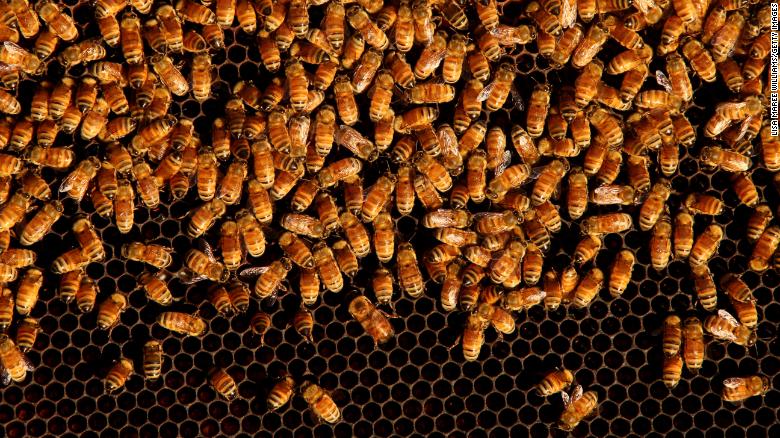Why are bees so important?
0:43
(CNN) --
There's a lot to love about bees.
They are crucial to growing many of our favorite and healthiest foods, as they move pollen from one plant to another, pollinating more than a hundred fruits and vegetables, including strawberries, potatoes, and apples.
Unfortunately, many bee species are threatened as a result of land use changes, pesticides, intensive agriculture, and climate change, but there are steps you can take to help them thrive.
In honor of World Bee Day on May 20, here are five surprising things you might not know about nature's hardest-working pollinators.
A bee pollinates a flower in Nova Friburgo, in the state of Rio de Janeiro, Brazil.
1. Bees like to 'dance'
Bees can communicate and make decisions by dancing.
When a bee searches for and inspects a new nest, it uses a wag dance to announce and debate its merits.
The better the site, the longer and harder the bee will dance.
If another bee bumps into a dancing bee, she'll go check the place out, and if she likes it, she'll wiggle too.
advertising
There are fewer wild bees on public records 0:46
Over time, the dynamics of the waggle dance cause 20 to 30 bees to agree on the best nest site, and they communicate their decision to the rest of the swarm by making high-pitched sounds and buzzing their wings among the other bees.
2. Bees can use tools
This is how bees defend themselves against murder hornets 1:43
Bees in Vietnam and other parts of Asia are threatened by predatory species of giant hornets that attack bee colonies, killing the adults defending the nest and attacking the young bees.
In particular, the voracious hornet species Vespa soror is capable of destroying the hive in a matter of hours.
To ward off such attacks, bees have been observed collecting fresh animal feces and smearing it around the entrance of their hive.
The researchers, who published their findings last year, call it "fecal spotting."
The study team believes that the poop repels predatory hornets (which are similar to murder hornets) from the nest by reducing the time the hornets spend trying to breach the nest.
"Faecal staining stands out as extraordinary for several reasons. It is the first report of honey bees of any species foraging for materials that are not derived from plants or water-based fluids. It is also the first clear example of honey bees using a tool in nature," the study said.
3. Bee poop almost caused a confrontation in the Cold War.
In the 1980s, "yellow rain," small yellow spots found on jungle foliage in Laos and Cambodia, was thought to be chemical weapons residue.
Refugees said the yellow rain caused illness and death.
The accusations led the United States to accuse the then Soviet Union and its allies of chemical warfare.
Bee experts later discovered that the yellow dots were excretions from massive swarms of wild bees.
More than 15,000 bees surprised a man in his car
4. Bumblebees get a bad temper when they're hungry.
The plants produce dazzling flowers laden with nectar to attract pollinators, but what's an impatient and hungry bumblebee to do when those flowers haven't bloomed yet?
When pollen was scarce, bumblebees damaged the leaves of tomato and mustard plants in a unique way that resulted in the plant flowering up to 30 days earlier than unnibbled plants, scientists in Switzerland and France found.
For bees, pollen is a source of protein that they need for their young.
However, warmer temperatures as a result of the climate crisis mean that bees are waking up earlier after hibernating for the winter to find the flowers they need to feed on that have not yet bloomed.
Flowering time, which depends on light exposure, is less affected by climate change.
This creates a mismatch that can leave bees without food in early spring.
5. Humans have been exploiting bees for thousands of years.
Bees on a hive at the Urban Bee Hive in Woolloomooloo on May 14, 2021, in Sydney, Australia.
A cave painting in Spain believed to be 8,000 years old shows a human being collecting honey from a ladder.
Traces of beeswax on pottery also suggest that early farmers kept bees 9,000 years ago.
Honey has also been found in tombs in ancient Egypt.
Honey was probably a rare delicacy in a prehistoric diet that had few sweet foods and may have had medicinal uses.
Beeswax could have been used to make waterproof pots or as glue.
Today, honey may offer new hope in the fight against antibiotic resistance.
Contains natural antibiotics to help the body fight infection.
Scientists are working on ways to make the sticky substance easier to apply to wounds and could be used in surgeries, war zones, and in our own homes.
Editor's Note: This article was originally published in 2021.
BeesInstaNews

